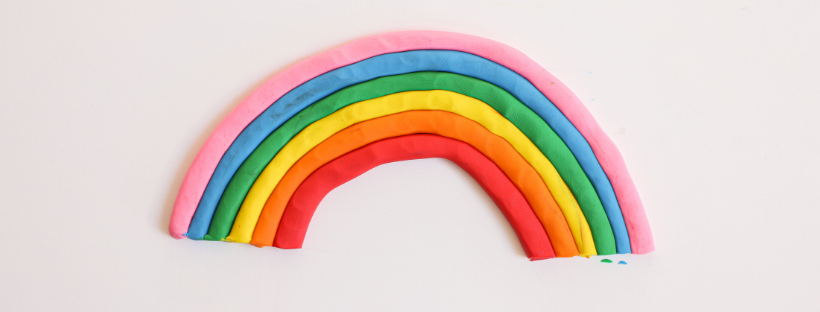
Are you stressing to find new exciting and also pedagogical lesson plans for the children? Rainbows are lovely and an interesting topic to explore all year round! You can combine multiple learning areas with the theme; for example science, expressive arts and design, or mathematics.
Below you can find a selection of different kinds of rainbow activities for children inspired by Little bins for little hands! You can for example organize an entire theme week around rainbows or then choose a single activity.
The most important thing in the rainbow activities is of course the colors! There are 7 colors in the rainbow; violet, indigo, blue, green, yellow, orange, and red. All activities include all the colors and children will surely get familiar with all of them during the activities.
1. Lego rainbow
Build a Lego or Duplo rainbow with children! First of all, look for colorful Lego bricks.
You will need:
- Lego bricks in all the colors of the rainbow
- White Lego bricks for clouds
- A base plate
Encourage children to try to build their own rainbows by using their creativity and imagination! The only rule is they have to have all the seven colors included. In case you need some help and inspiration for Lego rainbows, look here.
2. Rainbow water + paper experiment
In this scientific experiment, children will be amazed how the colors of the rainbow travel on paper!
You will need:
- Water
- 9 identical glass jars
- Food coloring (red, blue, yellow)
- Paper towels
- Small spoons
- Scissors
Take the glass jars and add water + food coloring to them (3 x red, 3 x yellow, 3 x blue). Try to add the same amount of food coloring to each jar and stir.
Cut thin and long strips of paper towel. The idea is that the paper strip fits in the glass jar so adjust the size based on the glass jars.
Organize the glass jars into a circle so that they are in order (red, yellow, blue, red, yellow, blue). Place the paper towel strips into the glass jars. There will be two ends in each tube so that the circle becomes finalized.
Wait and watch how the colors meet and mix. You can ask the children to anticipate what is going to happen. In case you want to see more information about the experiment, click here.
3. Real rainbows
If you are lucky you might get to see a real rainbow outside when it is both sunny and rainy! If that is not likely, you can create a rainbow by yourself!
You will need:
- CDs
- Flashlight
- Crystal or prism
CDs + Flashlight = Make rainbows using a small flashlight and a CD. Shine the light from your flashlight onto the surface of the CD to make a bold beautiful rainbow.
Crystal + Natural light = Use a crystal or a prism and natural sunlight to make rainbows everywhere. Tiny rainbows appear all over the ceilings and walls as the light touches the crystal/prism.
Let the children get creative and test out to see if they can come up with more ideas on how to make rainbows by using flashlights or natural light.
Kindiedays lesson plans - activities in all learning areas!
4. Playdough rainbow
Little hands get busy while molding cute little play dough rainbows!
You will need:
- Play dough in all the colors of the rainbow
Form long "worms" out of the play dough and place them on the table in a curved shape to make a rainbow.
In case you do not have play dough, no need to worry! You can make play dough by yourself and color the play dough by using food coloring. Click here for more instructions or print out the play dough recipe directly.
5. Rainbow oobleck / slime
This is a great sensory activity for children of all ages! Some truly love kneading it, while others dislike the funny texture - there is no other option but to test and see.
You will need:
- Cornstarch
- Water
- Food coloring
- Tray, bowl, spoon
- Measuring cups
Oobleck is basically a nice combination of cornstarch and water. Usually, the oobleck recipe is a ratio of 2:1, with one cup of water and two cups of cornstarch.
If you want to give your oobleck a color such as green, add food coloring to the water first. You will need to add a good amount of food coloring in order to make colors vibrant.
For more detailed instructions click here.
PS Remember to map the activities with your learning plans and objectives. And make observations of the children's work with Kindiedays Portfolio Learning software.
Have a colorful day!
.png)
.png)